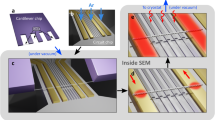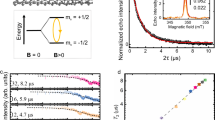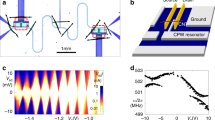Abstract
Quantum dots defined in carbon nanotubes are a platform for both basic scientific studies1,2,3,4,5 and research into new device applications6. In particular, they have unique properties that make them attractive for studying the coherent properties of single-electron spins7,8,9,10,11. To perform such experiments it is necessary to confine a single electron in a quantum dot with highly tunable barriers1, but disorder has prevented tunable nanotube-based quantum-dot devices from reaching the single-electron regime2,3,4,5. Here, we use local gate voltages applied to an ultraclean suspended nanotube to confine a single electron in both a single quantum dot and, for the first time, in a tunable double quantum dot. This tunability is limited by a novel type of tunnelling that is analogous to the tunnelling in the Klein paradox of relativistic quantum mechanics.
This is a preview of subscription content, access via your institution
Access options
Subscribe to this journal
Receive 12 print issues and online access
$259.00 per year
only $21.58 per issue
Buy this article
- Purchase on Springer Link
- Instant access to full article PDF
Prices may be subject to local taxes which are calculated during checkout




Similar content being viewed by others
References
Hanson, R., Kouwenhoven, L. P., Petta, J. R., Tarucha, S. & Vandersypen, L. M. K. Spins in few-electron quantum dots. Rev. Mod. Phys. 79, 1217–1266 (2007).
Mason, N., Biercuk, M. J. & Marcus, C. M. Local gate control of a carbon nanotube double quantum dot. Science 303, 655–658 (2004).
Sapmaz, S., Meyer, C., Beliczynski, P., Jarillo-Herrero, P. & Kouwenhoven, L. P. Excited state spectroscopy in carbon nanotube double quantum dots. Nano Lett. 6, 1350–1355 (2006).
Jørgensen, H. I., Rasmussen, G. K., Hauptmann, J. R. & Lindelof, P. E. Single wall carbon nanotube double quantum dot. Appl. Phys. Lett. 89, 232113 (2006).
Gra¨ber, M. R. et al. Molecular states in carbon nanotube double quantum dots. Phys. Rev. B 74, 075427 (2006).
Loss, D. & Divincenzo, D. P. Quantum computation with quantum dots. Phys. Rev. A 57, 120–126 (1998).
Petta, J. R. et al. Coherent manipulation of coupled electron spins in semiconductor quantum dots. Science 309, 2180–2184 (2005).
Koppens, F. H. L. et al. Universal phase shift and nonexponential decay of driven single-spin oscillations. Phys. Rev. Lett. 99, 106803 (2007).
Kuemmeth, F., Ilani, S., Ralph, D. C. & McEuen, P. L. Coupling of spin and orbital motion of electrons in carbon nanotubes. Nature 452, 448–452 (2008).
Nowack, K. C., Koppens, F. H. L., Nazarov, Y. & Vandersypen, L. M. K. Coherent control of a single electron spin with electric fields. Science 318, 1430–1433 (2007).
Bulaev, D. V., Trauzettel, B. & Loss, D. Spin-orbit interaction and anomalous spin relaxation in carbon nanotube quantum dots. Phys. Rev. B 77, 235301 (2008).
Fujisawa, T., Austing, D. G., Tokura, Y., Hirayama, Y. & Tarucha, S. Allowed and forbidden transitions in artīcial hydrogen and helium atoms. Nature 419, 278–281 (2002).
Elzerman, J. M. et al. Single-shot read-out of an individual-electron spin in a quantum dot. Nature 430, 431–435 (2004).
Klein, O. Die Reflexion von Elektronen an einem Potentialsprung nach der relativistischen Dynamik von Dirac. Z. Phys. 53, 157–165 (1929).
Katsnelson, M. I., Novoselov, K. S. & Geim, A. K. Chiral tunnelling and the Klein paradox in graphene. Nature Phys. 2, 620–625 (2006).
Trauzettel, B., Bulaev, D. V., Loss, D. & Burkard, G. Spin qubits in graphene quantum dots. Nature Phys. 3, 192–196 (2007).
Jarillo-Herrero, P., Sapmaz, S., Dekker, C., Kouwenhoven, L. P. & van der Zant, H. S. Electron–hole symmetry in a semiconducting carbon nanotube quantum dot. Nature 429, 389–392 (2004).
Minot, E. D., Yaish, Y., Sazonova, V. & Mceuen, P. L. Determination of electron orbital magnetic moments in carbon nanotubes. Nature 428, 536–539 (2004).
Cao, J., Wang, Q. & Dai, H. Electron transport in very clean, as-grown suspended carbon nanotubes. Nature Mater. 4, 745–749 (2005).
Deshpande, V. V. & Bockrath, M. The one-dimensional Wigner crystal in carbon nanotubes. Nature Phys. 4, 314–318 (2008).
van der Wiel, W. G. et al. Electron transport through double quantum dots. Rev. Mod. Phys. 75, 1–22 (2002).
De Franceschi, S. et al. Electron cotunneling in a semiconductor quantum dot. Phys. Rev. Lett. 86, 878–881 (2001).
Zener, C. A theory of the electrical breakdown of solid dielectrics. Roy. Soc. Proc. 145, 523–529 (1934).
Esaki, L. New phenomenon in narrow germanium p–n junctions. Phys. Rev. 109, 603–604 (1958).
Stoof, T. H. & Nazarov, Y. Time-dependent resonant tunneling via two discrete states. Phys. Rev. B 53, 1050–1053 (1996).
Fujisawa, T. et al. Spontaneous emission spectrum in double quantum dot devices. Science 282, 932–935 (1998).
Ono, K., Austing, D. G., Tokura, Y. & Tarucha, S. Current rectification by Pauli exclusion in a weakly coupled double quantum dot system. Science 297, 1313–1317 (2002).
Churchill, H. O. H. et al. Electron–nuclear interaction in 13C nanotube double quantum dots. Preprint at <http://arxiv.org/abs/0811.3236>.
Misewich, J. A. et al. Electrically induced optical emission from a carbon nanotube FET. Science 300, 783–786 (2003).
Kong, J., Soh, H. T., Cassell, A. M., Quate, C. F. & Dai, H. Synthesis of individual single-walled carbon nanotubes on patterned silicon wafers. Nature 395, 878–881 (1998).
Acknowledgements
It is a pleasure to acknowledge P.L. McEuen for the suggestion of using p–n junctions as tunable barriers, as well as D. Loss, T. Balder, I.T. Vink, R.N. Schouten, L.M.K. Vandersypen, and M.H.M. van Weert for useful discussions and suggestions. This research was supported by the Dutch Organization for Fundamental Research on Matter (FOM), the Netherlands Organization for Scientific Research (NWO), and the Japan Science and Technology Agency International Cooperative Research Project (JST-ICORP).
Author information
Authors and Affiliations
Contributions
G.A.S. was responsible for the experimental work. All authors discussed the results and commented on the manuscript.
Corresponding author
Supplementary information
Supplementary information
Supplementary information (PDF 1681 kb)
Rights and permissions
About this article
Cite this article
Steele, G., Gotz, G. & Kouwenhoven, L. Tunable few-electron double quantum dots and Klein tunnelling in ultraclean carbon nanotubes. Nature Nanotech 4, 363–367 (2009). https://doi.org/10.1038/nnano.2009.71
Received:
Accepted:
Published:
Issue Date:
DOI: https://doi.org/10.1038/nnano.2009.71
This article is cited by
-
Artificial-intelligence-assisted mass fabrication of nanocantilevers from randomly positioned single carbon nanotubes
Microsystems & Nanoengineering (2023)
-
Observation of interaction-induced phenomena of relativistic quantum mechanics
Communications Physics (2021)
-
Giant electron-hole transport asymmetry in ultra-short quantum transistors
Nature Communications (2017)
-
First-principles study on the electronic and transport properties of periodically nitrogen-doped graphene and carbon nanotube superlattices
Frontiers of Physics (2017)
-
Identifying signatures of photothermal current in a double-gated semiconducting nanotube
Nature Communications (2014)



